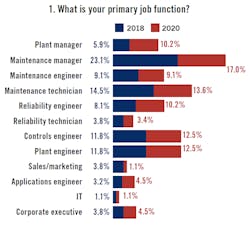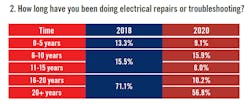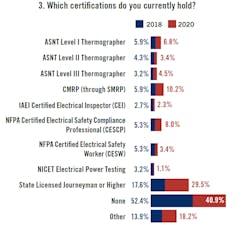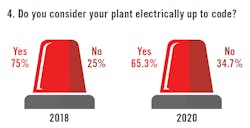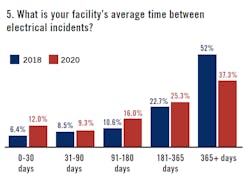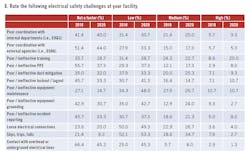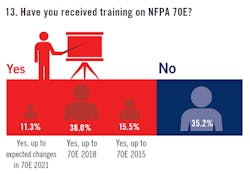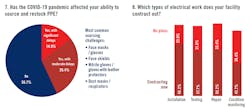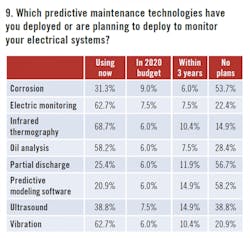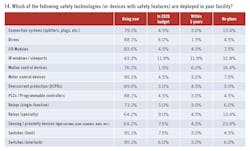2020 electrical safety survey results: Is your plant properly training workers on electrical safety?
It’s been nearly three years since we last surveyed Plant Services readers on their electrical safety practices, but it feels like only yesterday. What a difference a few years can make. In 2018, it did not occur to the editors to ask if a global pandemic (or any factor, really) was having a slowdown effect on your ability to source electrical PPE.
Here we are in 2020, and that question was the first update to this new edition of the survey, which was open in July and August of this year. The survey was extensive, and generated close to 100 responses from an audience whose primary focus is maintenance and reliability (see Figure 1), many of whom might not include electrical work as one of their core competencies.
However, the direction those responses pointed was quite clear. And yet again, a high majority of those who did respond to the survey reported that they have many years of experience with electrical repairs and troubleshooting, including 75% with more than 10 years and 67% with more than 15 years (see Figure 2). They also are highly credentialed, with almost 60% reporting that they have earned one or more certifications in this area (see Figure 3).
This is the good news. The bad news is that, since 2018, a higher number of survey respondents are reporting that their facilities are not up to code, from 25% then to 35% now (see Figure 4). Also, fewer plants are going more than a year between electrical incidents (see Figure 5).
It’s also worth sounding an alarm when it comes to electrical safety training. When asked to rate electrical safety challenges at your facility, the option that increased the most was “poor / ineffective training,” with the number of respondents who said this was a high concern more than doubling since 2018 (see Figure 6).
Two other survey questions asked about training. In a question that focused specifically on NFPA 70E, half of respondents indicated that they were trained up to the 2021 or 2018 standards; of the rest, 15% said they were trained up to 2015, and 35% said they had not received training on the standard (see Figure 13). In a separate question, 7% of respondents reported that they were being trained quarterly or greater; and, alarmingly, 10% of respondents said they had never received electrical safety training.
Now, about that PPE situation: this was some good news, that only 15% of respondents reported significant delays in their PPE supply chain due to the COVID-19 pandemic (see Figure 7). In a related question, results indicated that a significant portion of electrical work is currently being contracted out, from installation to condition monitoring (see Figure 8); PPE procurement may in part be a problem that affects contractors more that full-time plant staff.
Thanks to all who took time out of their day to take the 2020 survey. TW
After taking part in my first Plant Services survey, I wanted to talk about my experience and interest with industry survey data, and my first take on our electrical survey statistics.
I’ve been distributing, collecting, studying and promoting industry data for a long time. I started as a B2B journalist in the marina and boatyard industry and spearheaded the collection of a decade worth of business performance data, in a small industry where few states even knew how many waterfront businesses they actually had, let alone how those businesses were performing against their peers and within the industry as a whole.
Now, I’ve moved over to the manufacturing industry, which is a goliath in comparison, and an industry with a wealth of data from all over. It was a pleasure to dig into this first topic, as well as the survey information from Littlefuse, and here are a few of my thoughts.
I’m always naturally drawn to trends, or what we can draw from the data we have, even though this was only the second time Plant Services has done this survey. There are some good nuggets in there if you dig deep enough.
Considering the respondent profile in different ways is something that also interests me. If you’ve got a large enough response from the most important segments, this presents a snapshot of the industry. It’s always valuable to get a wide view, to see how the industry is performing as a whole, but sometimes interesting tidbits and valuable insights can be drawn from cross tabulating results and looking at distinct categories, such as the plant size or number of facilities and what verticals they represent.
In the case of this electrical safety survey, that could include how long the respondents have been doing repairs, what certifications they hold, or whether or not facilities have written policies in place for energized work. How the results vary in those different categories can tell you more about how those issues are affecting the industry in different segments. For example, size (or how many plants an organization manages) did not factor largely into whether or not respondents considered themselves electrically up to code. For organizations with five plants or less (66.2% of overall respondents) reported that 60.4% were up to code, while 39.5% were not. Likewise, organizations with six or more plants reported similar numbers; 63.6% were up to code, and 36.4% were not. And for the organizations that run 15 plants or more, 60% are up to code and 40% are not.
The same analysis can be done with vertical industries, which shows here that the transportation and commercial machinery industries have the highest number reporting electrical compliance at 100% of facilities. Chemical and pharma manufacturing have only 14% not up to code, and the automotive industry has the highest number reporting non-compliance (71%), followed by the oil and gas industries at 50% of facilities that reported they are not up to code electrically.
The more results you gather, and the longer you gather those numbers, the more telling they become. We hope you take the time to answer these surveys, and help us gather better and better data.
Plant Services last did this electrical survey in late 2017, reporting on the results in February 2018 (https://plnt.sv/1802-ES1) and while the two datasets don’t reveal huge long-term trends that we can report on, the short-term data can indicate short-term trends and areas that may fluctuate from year to year. These fluctuations can help editors in where to focus coverage on certain topics. I noticed a couple telling changes from this year’s results, and the survey that Plant Services did a few years ago.
Facilities reported on the average time between electrical incidents, and the number of facilities reporting more than 365 days as an average went down by 15%, to 37%, compared to 2018. More facilities were also reporting average incident times in a range from 181 to 365 days to 0 to 30 days. More facilities also reported being part of an OSHA investigation, compared to the last survey.
The trends in electrical safety challenges focused on training, PPE, and equipment maintenance. Facilities citing poor/ineffective training as a high challenge to electrical safety increased significantly in 2020, and far fewer facilities said training was “not a factor,” compared to the 2018 survey.
Not surprisingly, perhaps, the reports around PPE are a mixed bag. More facilities reported poor/ineffective PPE contributed to electrical safety challenges, and less facilities reported PPE to be “not a factor,” a decrease of more than 18%. However, those facilities reporting poor PPE as a “high” challenge to electrical safety (8%) also increased by more than three times, compared to the previous survey results. PPE as a hinderance to electrical safety affects a smaller number of facilities overall, and though that number is still increasing, a much larger number of facilities overall are not having issues with PPE.
Reports that poor/ineffective equipment maintenance served as an electrical safety challenge decreased significantly in 2020. About 14% reported that poor equipment maintenance was “not a factor,” compared to more than 27% in 2018.
In general, this quick look at short-term trends tells us that training overall is more of a concern for facilities, than PPE or equipment maintenance, and I think that these results suggest that electrical equipment maintenance is improving. I look forward to learning more about the manufacturing industry overall, what trends the industry is reporting, and what the numbers tell us. AT

